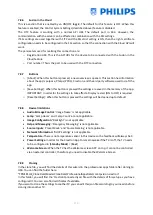
- 126 -
•
Encapsulation of 7TS packets per IP frame. Preferably, each UDP packet must contain exactly
7 data chunks otherwise the packet is not parsed and it will get lost
•
Multicast addresses need to be within following range: from 224.0.0.0 to 239.255.255.255
•
Duplex mode on the switches can be set to full duplex but automatic is recommended, as older
products do not support full-duplex mode. When the duplex mode is set to automatic, the
mode is determined after negotiation between the TV and switch
9.2
Settings for installing IPTV
To set up an IPTV installation you need to go through the virgin installation as described in the chapter
‘Virgin installation wizard’
.
After this you need to apply
following settings as described in the chapter ‘Professional settings’:
•
[
Dashboard
] [
Select Dashboard
]
→
[
Philips Home
]
Philips Home is comparable with the default dashboard from previous products.
•
[
Date and Time
] [
Source
]
→
[
Automatic NTP/Channels
]
•
[
Advanced
] [
Professional Mode
]
→
[
On
] (never turn this [
OFF
])
•
[
Advanced
] [
Power
] [
Standby Mode
]
→
[
Fast
]
Setting up this option on Green will reduce the energy consumption in standby, but will
increase the startup time dramatically
•
[
Channel
][
Channel Settings
][
IGMP Version for Multicast Channels
]
By default, IGMP version 2 will be used. When the switches are configured to a different IGMP
version, it is recommended to set the correct version in this menu, as this will improve the zap
time.
•
[
Wireless and Networks
] [
Control TV Over IP
] [
WebServices
]
Note:
Below settings are to be able to control the TV’s using CMND
o
[
Server URL
]: Set the URL correct to get the TV’s detected in
CMND
o
[
TVDiscoveryService
]
→
[
On
]
This is the web service through which a web server will detect the presence of TVs in
the IP network using the TV serial number or production code (and other data). This is
achieved by the TV polling the web service server periodically. For the server to
identify the TV uniquely, the TV details or parameters are being passed to the server
o
[
ProfessionalSettingsService
]
→
[
On
]
This allows changing or requesting the current professional settings parameters. It is
similar to WIxP's professional settings control, except that mechanism used here is
web services, instead of WIxP
o
[
IPUpgradeService
]
→
[
On
]
This will allow cloning and software update of the TV over IP via CMND
Note: There is no longer need to change your setting for upgrade over IP or RF. Both
will be checked automatically.
9.3
Installing IP Channels
Open the ChannelList.xml file as described in the chapter ‘ChannelList.xml in the clone file’.
For each IP channel in your network, an xml element needs to be inserted within the
<ChannelMap></ChannelMap>
brackets with the following format: (The
green
elements are the ones
that need editing)
<Channel>
<Multicast
url
=
"
[cast mode]
://
[ipaddress]
:
[port]
/0/0/0/VBR"
></Multicast>
<Setup
presetnumber
=
"
[number]
"
name
=
"
[channel name]
"
blank
=
"0"
skip
=
"0"
FreePKG
=
"0"
PayPKG1
=
"0"
PayPKG2
=
"0"
logo
=
""
TTV1
=
"0"
TTV2
=
"0"
TTV3
=
"0"
TTV4
=
"0"
TTV5
=
"0"
TTV6
=
"0"
TTV7
=
"0"
TTV8
=
"0"
TTV9
=
"0"
TTV10
=
"0"
></Setup>
Summary of Contents for 50BFL2114/12
Page 19: ... 18 ...
Page 120: ... 119 ...














































